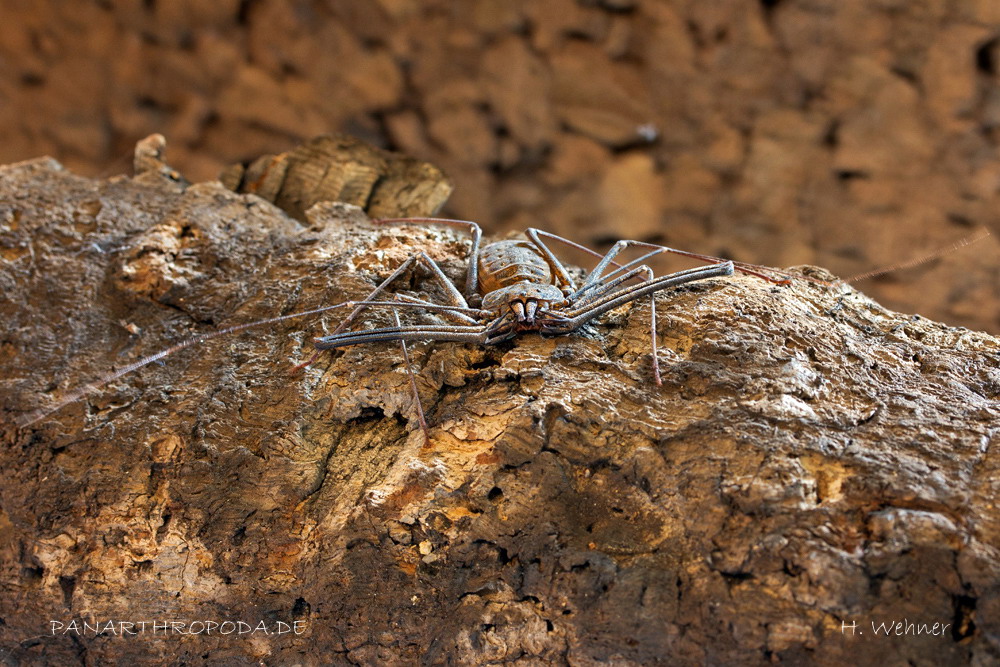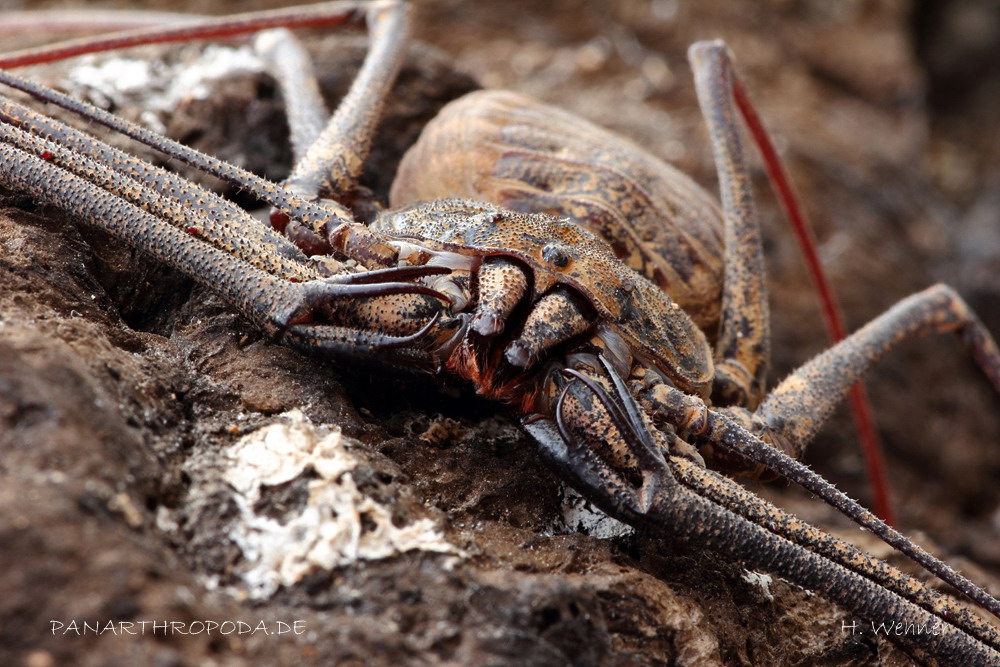- Charinidae
- Charontidae
- Phrynichidae
- Phrynidae

Euphrynichus bacillifer (Gerstaecker, 1873)

Adult female
Origin and occurrence
Euphrynichus bacillifer can be found in middle and southern Africa where, in contrast to its sister species Euphrynichus amanica, it is widespread. Populations of this species occur in Kenia, Tansania (on the island Zanzibar), Mozambique, Madagascar, Zambia, Angola, Zimbabwe and Malawi.
On the boarders between Kenia and Tanzania close to the coast the second species of the genus, Euphrynichus amanica, appears, too. Sympatric ways of life of those two spocies have been observed in this area, meaning the two share the same habitat. The animals occur in bigger caves, under bark and in cracks in more humid areas.
Appearance and sexual dimorphism
Individuals of this species can get rather big, but since my specimen I keep are not adult yet I can not make a statement about their maximum size. No terminal molt takes place and so these animals grow all their life, but obviously the intervals between molts get longer in time. Both sexes have extremely elongated pedipalps, but the male's pedipalps are longer still. This dimorphism can not be used for sexing any juvenile specimen, since the sped up growth of the male's pedipals starts later on.
To sex them before that one can take a look at the genital operculum on the ventral side. When little red hair are present at the posterior side it is without a doubt a female specimen. Femur and tibia of the pedipalps are thornless with the exception of the thorns on the distal end of the tibia, that form the basket. The third thorn of this basket will be reduced with every molt and will disappear completely over time.
In this specimen the bacilliform bulges on the anterior side of the pedipalp's tibia are namegiving. Euphrynichus bacillifer has three of those, of which the last distal one is much bigger than the other two in the adult state, in juveniles they are all of the same size. These bacilliform apophyses are occupied by several glands, that are used for communication inside the species. For example, during mating the male will place them on the chelicerae of the female.
These animals will reach maturity rather quickly, when the conditions are right it can happen as soon as in one and a half years. The smallest female that littered in my care had a carapace length of 6mm, width of 11mm, a total length of 18mm and a pedipalp tibia length of 20mm
Behavior
These animals are nocturnal, wander around in darkness and key their surroundings usind their first pair of legs, that has been altered into whips. When prey is found the pedipals are opened and the whip spider moves towards the prey item slowly. Finally the pedipals are closed quickly and the prey is encased in most cases.

Adult female
The animals are very skittish and flee into dark hideouts or cracks because of the tiniest draft or sudden illumination. When they do they will often move sidewards. When cornered they open their pedipals, that are usually closed like folding knives, and threaten or hit at the aggressor. When gripped carelessly they can hit behind themselves using the pedipalps and even bite. However this is not dangerous since whip spiders do not have any venom.
Euphrynichus bacillifer is very social, I have never had any casualties because of cannibalism - even during molts. The animals are densly pressed to each other during day and even sit on top of each other. However there should be some potential for aggression amongst adult males. When two adult males meet a highly retualizid fight occurs which usually does not couse any damage to the animals. The winner then walks over the looser which presses itself to the ground.
Mating is highly retualizied, too, in which the male will shove itself underneath the female to deposit the spermatophore.
Keeping conditions
The animals should be kept at 28-30 °C and a constantly high humidity. Offering a water bowl makes sense, too, since I could observe specimen drinking out of them on some occasions. The substrat is not as important since the animals rarely remain there, the substrat should just be fit for saving up water and regulating the humidity, so sand is not fit to be used. The substrat should be kept moist all the time, the animals bear with dryness very badly and die quickly. The young are even more sensitive. A good airflow should be assured, too.
The animals need big running surfaces, which does not mean a big container is needed, it can be done by offering a high number of stacked bark pieces, which will also offer a good number of hiding places. The container should however at least be as big as the animals need to totally spread their whips, on top of that the animals need quite some room for molting. For feeding crickets of a fit size can be used.
Mating and raising the young
When males and females are kept together they will most likely mate. A sure sign is the finding of spermatophores. Since I keep them together all the time I can not say how long it takes for the females to litter after fertilization.
Some time after mating the female will deposit a fibrous sack of eggs out of its opisthosoma, which will be placed underneath the opisthosoma with the help of a fibrous secretion. After hardening this will form a hard eggsack. Now comes the time in which a good balance of humidity is needed! If kept too moist the eggs will rot and if kept too dry they will dry out. Dead eggs are colored black and in most cases the other eggs will die off, too. In this case the eggsack will be thrown off after some time. The females carrying an eggsack should not be fed too well, because a swelling of the opisthosoma could cause the eggsack to fall off, too.
After about one month the young emerge, they are clear and the limbs are not fully developed yet - these young are called Praenymphae. These will climb onto the opisthosoma, some even stick to the underside if there is insufficient place elsewhere. Two weeks later the young molt to autonomous, prey catching young with fully developed limbs, which will leave the mother's safety. The size of the litter depends on the size of the mother itself, where bigger mothers produce bigger litters and vice versa.
I bring the young up in round cans over which I put stockings to aid the animals when molting from this lid and which also helps with the airflow.
Diagnosis
If one has an eye on the need for humidity these animals are easily kept. The social behavior is especially interesting and makes them easier to keep in smaller spaces then other species, that are to be kept apart.
F. Schramm, authored 2011

